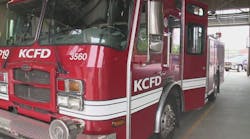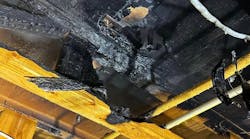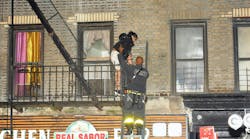I also learned that media releases make my job easier. Instead of getting numerous calls from the media asking the same questions and myself repeating the same thing over and over again, the media release can be disseminated and cut down on the number of calls, if it is done correctly.
How to compose a successful media release
First of all, it needs to be done on a template in your computer or on paper. You want your release to look professional and "eye catching."
Most releases are sent to the media via the fax machine. Many PIOs don't know that the ringer in the fax machine in most newsrooms are disconnected or shut off. This is because they are constantly bombarded with releases from numerous sources and organizations trying to get their story on the news. Every once in while, someone in the newsroom will pick up a batch of releases from the fax machine and thumb through them to pick out the more interesting ones. This is why it is so important to make yours "eye catching," you want to catch their attention. On my releases, I have the words "FIRE NEWS" in big letters so it really stands out.
Your release should contain the official name of your department, a contact name and telephone number and any other required information of your department or city. Our city requires the name of the fire chief, mayor and city council members on all outgoing releases.
It should also contain the date and time of the release and some sort of tracking number for your files. I track ours by using the year and the number of the release for that year, such as: 03-127, which means it is the 127th release for the year 2003.
I keep my template in my computer in Microsoft Word. This way each time I wish to do a release, it is already in the computer and all I have to do is compose the release information.
Writing the release
Releases should be written in the "inverted" style, that means the more important information is at the beginning of the release and less important and support information is found later in the release.
The first paragraph should only contain two-to-three sentences. It should tell the entire story of the release, and yet it should make you want to read more. It is in this first paragraph where the editor or assignment desk decides whether they want to read the rest of your release and consider it for a story or trash it.
The rest of the release should support that first paragraph and it must answer the following questions:
- WHO
- WHAT
- WHEN
- WHERE
- WHY
- HOW
It is vital that every release contain all of those points. The time of the incidents usually takes care of the when, while the address of the incident takes care of the where. What is the release about, a new rig or a fire response? Who is involved in the release you are writing about, fire victims or members of the department? Why and how are a little more difficult, but answer the question such as what caused the fire or how did it start.
Use layperson, not technical terms. It should be written so a student in a sixth grade class could easily understand it and discuss it with you.
It is absolutely imperative that you make sure all the information in your release is correct. If you are not sure, do not include it.
Format of the release
Releases should be held to one page, on one side of the paper with a font size of 10-12. You should double-space. This way editors and reporters can add notes in between the lines.
At the end of the release, indicate it is the end. Some use the signs: ## or -30-, which was used for many years by the media to indicate it was the end of the release when it was sent via teletype machines.
Dissemination of the release
You should try to send out your release as quickly as possible after an incident or send it well in advance of a planned event so the media has a chance to make plans.
Media releases are usually sent via fax machines, some by e-mail or they can be posted on the web. Obtain the fax machine telephone numbers of the media outlets you want your release to go to in advance and program it into your fax machine so when it needs to be sent out immediately, you don't have to look up the number. There are programs for computers that can disseminate via fax if it is hooked up to a telephone line. I use a laptop computer to write my releases. I also have a fax program in the laptop, so when I am done writing it, I can immediately fax it out.
When to send media releases
During the day is usually the worst time to send a fax, but if you had a working or important event or incident, you have no choice. When I plan to send out a fax, I usually send it out between 2:00 and 3:00 AM. Usually no one else is sending faxes to the media at that hour and I know they will see it lying in the fax machine. It is also there, fresh so when editors and assignment editors arrive in the morning to decide what stories will be covered that day, it is sitting right in front of them.
Releases may also be sent during an emergency to disseminate immediate information such as evacuation routes or location of shelters. It is imperative that you have your template or stationary ready to use at a moments notice and you have a way to disseminate the release without delay.
Other hints
Have someone else proof read your release before you disseminate it. Use the spell and grammar check on your computer if it is available. The only way you learn to send out good releases is to practice.
You may also post them on your department website so people can read what your department is doing.
You can see a number of releases on our department website at: www.lasvegasfire.org. Click on "Public Information & Media Relations" in the left hand column and then on "Fire Rescue Releases."
Some other important facts
Make sure you get your release out early before deadlines. Learn the deadlines of you local media. Usually it is one to two hours before the broadcast of television and radio and usually 10-12 hours for the print media. If it gets in after the deadline, there is a good chance it will not make the news.
If your department is planning to have an event, such as an open house or awards presentation, send your media advance well in advance. I like to send our departments one week in advance, the day before and then the morning of the event. This helps the media with advance planning.
If you have a special event or press conference, compose your media release in advance and then distribute it after the event to those of the media that attended. Make sure you fax it also.
If you use direct quotes in your release, make sure the person you are quoting has approved it first.
Keep you releases in a safe place, which they are easily accessible. There is always the possibility they will be needed at a later date by the media to review an incident or they could be used in a legal case. This is why it is extremely important to ensure the information you put in the release is accurate.
When I file my releases, I sometimes attach reports or notes of information to my release, especially if I feel I may have to use it again in the future or it might be used in a legal case.
I must admit when I first become a PIO several years ago I did not like writing releases. After doing it for several years, I found that I really enjoy it. The personnel of our department also enjoy it as it lets every member know what went on while they were off duty or in another part of the city. (On my releases I also list the units that responded so members know who went on the call.)
The only way you get good at media releases is to write them and often. The media will appreciate what you have done for them and you will appreciate the fact that you will not have to repeat yourself several times over.
If you have any questions or comments, please call me at 702-229-0145 or e-mail me at [email protected].





